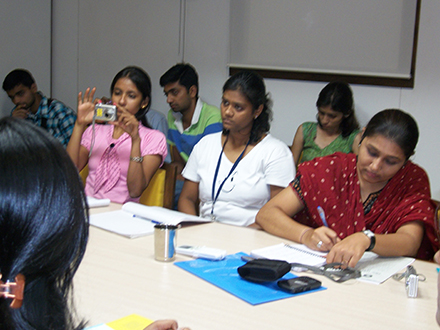Communication
Communication plays a crucial role in the lives and struggles of poor women workers by connecting them to other groups of self-employed women, the public, policy planners, and other government officials.
IASEW utilizes several different print and electronic mediums to foster these dialogues as outlined below:
Anasooya
A bimonthly newsletter founded in 1982 as a forum to present the experiences, ideas, and work of informal sector women workers, Anasooya serves as a link between SEWA members and other self-employed workers across various geographical, social, and cultural boundaries. Published in Gujurati, the newsletter brings women’s issues to the macro level.
For further details, please visit www.anasooya.org

Video SEWA
Since its inception in 1984, Video SEWA has been working to deliver technology into the hands of the common people and to use video as a tool for development communication. Video SEWA has produced countless tapes and more than a hundred programmes on organising, training, and advocacy. These tapes reach villagers and slum dwellers in Gujarat as well as policy makers in Delhi and Washington.
Gradually, video has become an integral part of SEWA’s activities. For women workers and the members of SEWA, Video SEWA is a source of information as well as inspiration.
View SEWA videos on our youTube channel.
Akashganga
Akashganga, the print magazine for the daughters of SEWA members established in 1996, is published monthly in the Gujarati language to ensure the holistic development of adolescent girls. The girls themselves are the writers, artists, and editors. They contribute their own artwork, stories, quizzes, puzzles, poems and articles covering a wide variety of subjects, including information on health, history, and science.
Radio SEWA
SEWA Radio's research has shown that radio is a powerful medium for education and communication that reaches even the remotest of villages in India, where members like home-based workers avidly listen to the radio while they work.
SEWA utilizes various radio programmes to widen its reach, give women a place where they can talk about themselves and their issues, educate members on government schemes, provide information on health and hygiene, and to raise awareness of the SEWA organisation.
Rudi no Radio
In April 2005, SEWA began its first community radio programme, Rudi no Radio (Rudi’s Radio). The programme is symbolically named after SEWA’s first member, who worked to spread the association’s wings to rural areas. The original programme was a weekly 15-minute show that was produced and broadcast by SEWA employees for a rural audience. In each episode, the host, Rudiben, talks informally with members of her village about things that affect them as women and as labourers. In that spirit, the programme has extended to the Ahmedabad-Vadodara area on All India Radio-Ahmedabad (AIR-Ahm.). Based on listener responses, we estimate that 500,000 listeners tune in weekly for the show.
For further details, please visit www.radiosewa.org.
IASEW accepts assignments from other organisations for video and radio productions. To find out more, please contact us.

